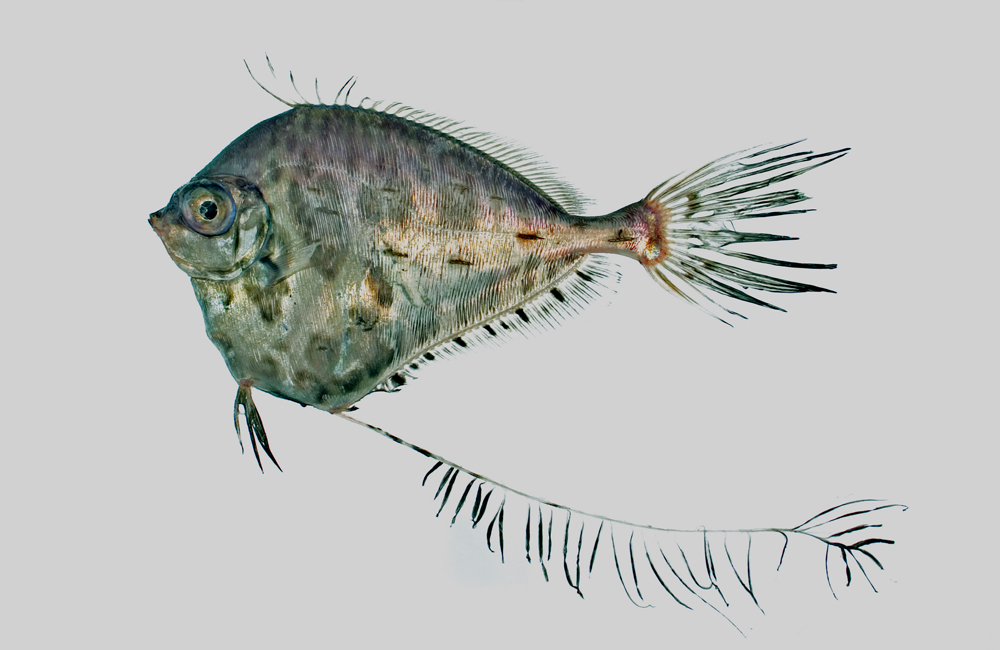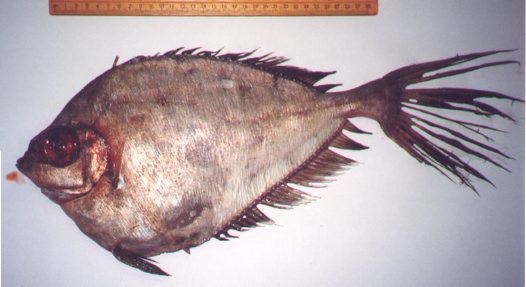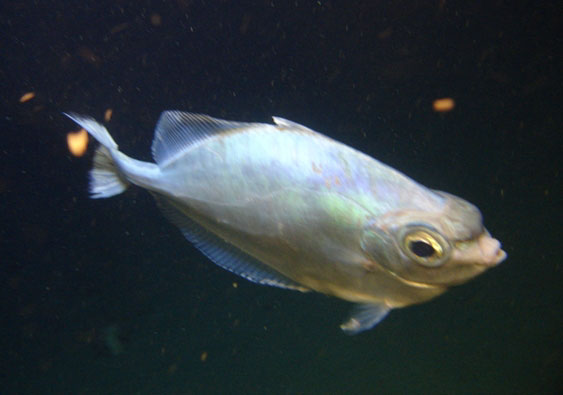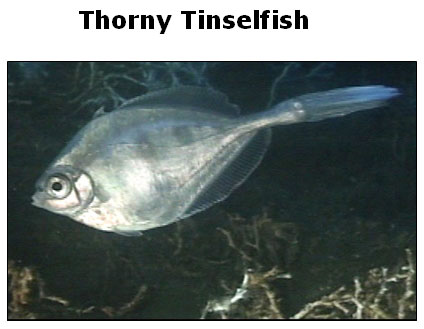
Grammicolepis brachiusculus
FAMILY
Grammicolepidae
TAXONOMY
Grammicolepis brachiusculus Poey, 1873, Cuba.
OTHER COMMON NAMES
English: Diamond dory, deepscale dory; Spanish: Palometa
oropel.
PHYSICAL CHARACTERISTICS
Attains a total length (including the tail fin) of about 2 ft, 5 in
(72 cm) and a weight of 9 lb (4 kg). The head and body are
deep, very compressed, and shaped like an oblong disc, or dinner
platter; juveniles are diamond-shaped. The body, cheeks,
and operculum are covered with vertically elongated scales. The
mouth is small, and the maxilla has two or three ridges, bound
to the ascending processes of the premaxillae and loosely connected
to the palatines. The jaws have one or two rows of
minute, slender teeth, and the vomer may or may not have three
or four minute, slender teeth. There are two dorsal fins, the first
with six to seven spines and the second with 31–34 unbranched
soft rays. The anal fin has two spines and 33–35 unbranched
rays. The tail fin has 13 branched rays. The pelvic fins have one
spine and six branched rays; there is a row of 34–36 small spines
along each side of the dorsal and anal fin bases.
Juveniles have a greatly elongated first anal fin spine and
second dorsal fin spine. The pelagic juvenile stage (4–8 in, or
10–20 cm in standard length) looks quite different from the
adult. The body is more compressed and angular, with 10–13
prominent, flattened, bladelike, spiny scutes projecting laterally
from the surface of each side of the body. Each scute is an outgrowth
from a scale whose basal part is divided, overlapping
both sides of the one behind. On the base of the larger scutes
are retrorse spinules. The scutes become smaller as the fish
grows, and they eventually shrink to nothing as the fish transforms
to an adult at about 10–12 in (25–30 cm). Adults are silvery
in color, with bronze reflections. Juveniles are silvery,
with irregular black blotches on the body, black spots on the
tail fin, and 5 black bars on anal fin.
DISTRIBUTION
Tropical and temperate waters of the eastern Atlantic from
France to South Africa; also known from Japan, Hawaii, Australia,
and the western Atlantic from Canada to Suriname.
HABITAT
Adults usually are caught with trawls near the bottom, at
depths of 1,333–3,000 ft (400–900 m).
BEHAVIOR
The
BEHAVIOR
of the thorny tinselfish is poorly known, as this
species has yet to be observed in shallow water.
FEEDING ECOLOGY AND DIET
No information has been published on the diet of the thorny
tinselfish. It probably feeds on plankton and small benthic invertebrates.
Juveniles are subject to predation by a variety of
piscivores. Adults are eaten by some large sharks and
lancetfishes.
REPRODUCTIVE BIOLOGY
Poorly known. Probably a broadcast spawner with pelagic eggs
and larvae.
CONSERVATION STATUS
Not listed by the IUCN. Its apparent rarity may be due to the
difficulty in sampling fishes from depths of 1,333–3,000 ft
(400–900 m).
SIGNIFICANCE TO HUMANS
None known.
Photo Gallery of - Thorny tinselfish





 Animalia Life
Animalia Life